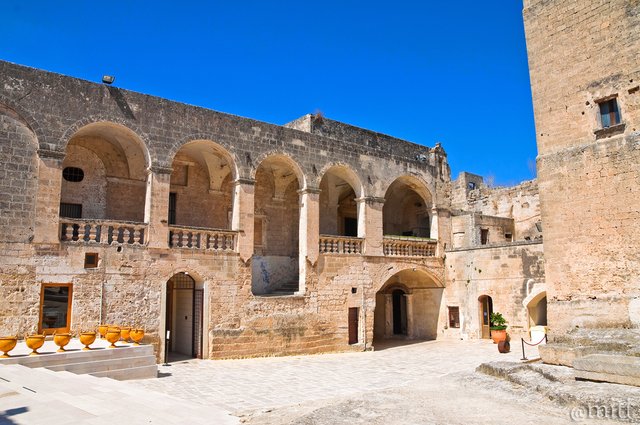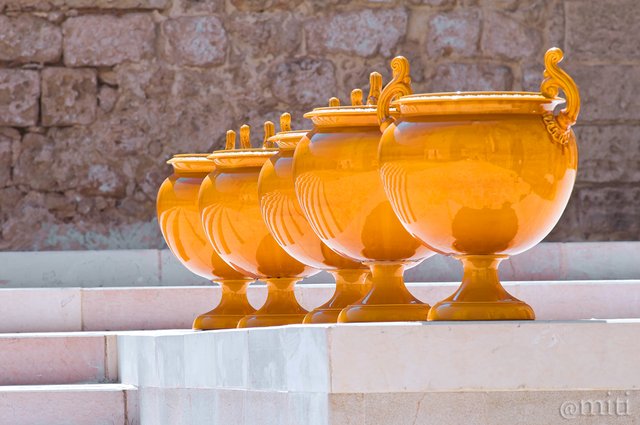A Journey through Italy: one photo every day #93 - GROTTAGLIE [ENG/ITA]

The Episcopio Castle (Author's photo - All rights reserved)
Il Castello Episcopio (Immagine dell'autore - tutti i diritti sono riservati)



Ciao a tutti,
questo è un viaggio attraverso l'Italia. Posterò una foto al giorno con una brevissima descrizione. Spero vi piaccia!

Grottaglie è una borgo della provincia di Taranto, nella regione italiana meridionale della Puglia. Si trova sul pendio di un colle delle Murge, chiamato Monte Samuel Pizzuto, nell'entroterra di Taranto, territorio che si estende fino a Matera, in Basilicata. Il territorio è segnato dalla presenza di anfratti, ai cui lati sono state scavate molte grotte.
Il nome latino di Grottaglie "Cryptae Aliae" significava molte caverne. Le prime comunità umane dimorarono in insediamenti rupestri che gradualmente furono abbandonati per occupare le zone più in alto dove fondarono villaggi fortificati.
La parte vecchia di Grottaglie era una delle cittadelle della zona, citata nei documenti medievali come Casale Cryptalerum. Nel secolo XI, i Normanni donarono il feudo all'arcivescovado di Taranto che fortificò il paese nel XIV secolo e costruì il castello e la Chiesa Matrice.
La crisi dei secoli XV e XVII divise la città in due diversi feudi, uno laico e l'altro arcivescovile.
La dominazione spagnola durante il XVII secolo gettò la città in un periodo di miseria che continuò fino al XVIII secolo, quando il conflitto tra i due feudi e il popolo causò l'abolizione degli stessi. Nel secolo successivo ci fu un'espansione della città fuori dalle mura urbane ma fu ancora un periodo di disorientamento politico e si sviluppò il brigantaggio. Dopo questi eventi e l'Unità d'Italia, la storia di Grottaglie fu comune a quelle delle altre città del sud.
Passeggiando per l'incantevole centro storico, completamente scavato nel tufo, a sua volta caratterizzato da vicoli tortuosi e case dal soffitto basso, ci si imbatte nel quartiere della ceramica, un luogo creativo, dove vengono prodotte sofisticate opere in terracotta. Le ruote dei torni girano incessantemente in più di 50 botteghe artigiane, dove generazioni di artigiani hanno lavorato e continuano a dare forma a piatti, stoviglie, fontane, cavalieri e signore, oltre alle famose ceramiche smaltate, i "pomi", vere e proprie icone dell'arte simboli dell’arte figula grottagliese. Gli artigiani sono stati in grado di sviluppare una fiorente attività artigianale oggi riconosciuta e apprezzata in tutto il mondo.
Meritano sicuramente una visita anche la Chiesa Matrice, il Castello Episcopale, il Museo della Ceramica, la Chiesa di San Francesco di Geronimo, la Gravina del Fullonese e il Santuario di Santa Maria Mutata.
Il castello episcopale non è lontano dal famoso quartiere delle ceramiche, nella parte più antica della città; il castello di Grottaglie è stato per secoli il simbolo del potere feudale della comunità episcopale di Taranto. La sua stratificazione storica non è ancora del tutto chiarita, sebbene sia plausibile che già all'inizio del XV secolo la torre principale, le mura fortificate con i due bastioni e le camere private dell'arcivescovo al primo piano potessero essere lì.
Cosa vedere: il Centro storico, il Castello Episcopio, la Chiesa Matrice, il Distretto della Ceramica, il Museo della Ceramica, la Chiesa di San Francesco de Geronimo, la Gravina del Fullonese, il Santuario di Santa Maria Mutata, Cicinelli Palazzo, Palazzo Urselli, Palazzo Blasi, Palazzo Maggiulli-Cometa, la Chiesa San Francesco da Paola e Chiostro.

Hello everyone,
I began a Photo Journey through Italy. I will post one photo every day with a little note of explanation. I hope you like it!

Grottaglie is a town in the province of Taranto, in the Southern Italian region of Puglia. It is located on the slope of a hill of the Murge, called Monte Samuel Pizzuto, in the hinterland of Taranto, territory that extends up to Matera, in Basilicata. The territory is marked by the presence of ravines, on the sides of which were dug many caves.
The Grottaglie latin name “Cryptae Aliae” meant many caverns. The first human communities dwelled in rupestrian settlement that gradually were abandoned to occupy the high land on top where they founded fortified villages.
The old part of Grottaglie was one of the citadels in the area, referred to in Medieval documents as Casale Cryptalerum. In the XI century, the Norman donated the fief to the Archbishopric of Taranto that fortified the village in the XIV century and built the castle and the Matrix church.
The crisis of the XV and XVII centuries divided the city into two different fiefs, one laical and the other one archiepiscopal.
The Spanish domination during the XVII century threw the city into a period of misery that continued until the XVIII century when conflict between the two fiefs and the people causing the abolition of the fiefs. In the following century there was an expansion of the city out the urban walls but it was still a period of political disorientation and the brigandage developed. After these events and the Unity of Italy the Grottaglie history was common to those of the other Southern cities.
Surrounding the lovely historic centre, completely dug in the tufo, itself characterized by winding alleys and low-ceilinged houses, is the pottery district, a creative place, where sophisticated terracotta works are produced. Potter’s wheels turn ceaselessly in more than 50 craft shops, where generations of artisans have worked and continue to give shape to plates, crockery, fonts, knights and ladies, as well as the famous glazed ceramic “pomi,” veritable icons of the art of Grottaglie’s “figuli” (master potters). The artisans have been able to develop a flourishing artisan activity today recognized and appreciated all over the world.
Certainly deserve a visit also the Mother Church, the Episcopal Castle, the Ceramics Museum, the Church of San Francesco de Geronimo, Gravina del Fullonese and the Saint Mary Mutata Sanctuary.
The Episcopal Castle is not far from the famed Ceramics quarter, in the town's oldest part, the castle of Grottaglie has been for centuries the symbol of feudal power of Taranto's episcopal polity. Its historical stratification has not been fully clearified yet, although it is plausible that already in the early 15th century the main tower, the fortified walls with the two bastions,and the archbishop's private chambers on the first floor, might have been there.
Thing to see: the Historical center, the Episcopio Castle, the Matrix Church, the Ceramics District, the Ceramics Museum, the Church of San Francesco de Geronimo, the Gravina del Fullonese, the Saint Mary Mutata Sanctuary, Cicinelli Palace, Urselli Palace, Blasi Palace, Maggiulli-Cometa Palace, the San Francis of Paola church and cloister.

| Tipo di foto / Category | Paesaggio / Landscape view |
| Esposizione / Settings | 1/320 sec, ISO 200, f/10 |
| Camera | Nikon D5000 |
| Lente / Lens | Tamron SP 17-50mm f/2.8 XR Di II LD |
| Filtro / Filter | Polarizzatore Hoya / Hoya Polarizing filter |
| Cavalletto / Tripod | Manfrotto MKC3-P01 |
| Località / Location | Grottaglie (Taranto), Italia |
| Software | Photoshop |


Some example of terracotta works (Author's photo - All rights reserved)
Alcuni esempi di opere in terracotta (Immagine dell'autore - tutti i diritti sono riservati)
Italy has a lot of historic buildings
Yes, it's true.
Congratulations, Your Post Has Been Added To The Steemit Worldmap!
Author link: http://steemitworldmap.com?author=miti
Post link: http://steemitworldmap.com?post=a-journey-through-italy-one-photo-every-day-93-grottaglie-eng-ita
Want to have your post on the map too?
I was just looking at the cave dwellings or the old ravines where humans had settled before and was surprised to see how many of them were there.
It is humbling to note that before cites and citadels humans had survived under rocks and only later learned to use those rocks to make dwellings of their own. The flow of history is almost musical.
If history has proven anything it is that evolution always wins.
Trovare luoghi in cui l'artigianato è ancora presente è raro: perle di questo tipo andrebbero esaltate e te lo hai fatto molto bene.
La manodopera è un bene preziosissimo per il nostro Paese, che però si sta perdendo a favore dell'industrializzazione e della standardizzazione.
Un prodotto artigianale è un prodotto unico!
Verissimo e per fortuna in Italia ci sono altri esempi di amministrazioni che hanno deciso di puntare sull'artigianato come marchio distintivo del proprio territorio.
Those terracotta artifacts look really beautiful and of modern design. I can easily imagine these yellow ones in some very modern interior. It's certainly tempting to visit Grottaglie!
It's a place worth visiting, especially if you like the handicrafts
nice post and photographi
Thanks
your post is very great friend. my upvote.
this is a very nice home
You got a 34.30% upvote from @ocdb courtesy of @miti!
wow, am really amazed by this great post, nice work @miti u made my day with this lovely photos